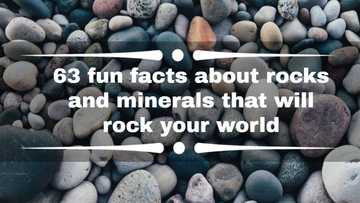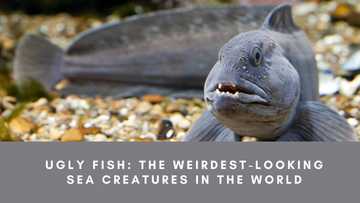10 important properties of water everyone should know about
What are some of the most crucial properties of water that you know? Up to 60% of the human adult body is made up of H2O, and it plays crucial roles in the bodies of living things, such as food movement, skin hydration, and much more. A look at both the physical and chemical features of water will help you understand its importance in relation to some of its features.

Source: Getty Images
Chemical compounds exhibit unique features that are used for their identification. These traits are determined by what you observe when you look at them and how they react when combined with other substances.
10 properties of water
Water is undoubtedly one of the essential compounds on planet earth. It plays a critical role in the bodies of living things.
Pure water is colourless, odourless, and tasteless. Like any other chemical substances, it has unique properties that distinguish it from the rest. So, what are the properties of water?
1. Water is polar
In chemical bonding, polarity refers to the distribution of electric charges over the atoms joined by a bond. Water is a molecular structure, which is composed of an oxygen atom and two hydrogen atoms.

Source: Getty Images
The hydrogen atoms are covalently bonded to the oxygen one to form molecules. These molecules are then attached via hydrogen bonds.
Four pairs of electrons surround the oxygen atom. Two pairs are involved in bonding with the hydrogen atom, while the remaining two are unshared and on the opposite of the oxygen atom.
Because oxygen is more electronegative than hydrogen, it attracts the shared electrons and has partial negative charges. The less electronegative one (hydrogen) becomes partially positively charged.
As a result, the molecule is slightly charged at the ends. These partial charges cause the attraction of the molecules to form hydrogen bonds.
2. It is a universal solvent
Water is a universal solvent because most substances dissolve in it. This is one of the special properties of water, and it is made possible because of its polar characteristics.
Considering that water is slightly charged at the ends (oxygen is negatively charged and hydrogen is positively charged), it can dissociate ionic compounds. Dissociation refers to the separation of negative and positive ions in an ionic compound.
When an ionic compound is put in water, it dissociates into positive and negative ions. The positive ions are attracted towards oxygen (which is negatively charged), and the negative ions are attracted towards hydrogen (which is positively charged). This is how dissolution occurs.

Source: UGC
Being a universal solvent, it shouldn't be confused to mean that it dissolves every substance. Some organic compounds, such as oil, wax, and many more, do not dissolve in water.
3. Has high surface tension
Surface tension refers to the property of a liquid that allows it to resist an external force. The property is made possible because of cohesive forces. If you carefully place a needle on the surface of H2O, it floats because of surface tension.

Read also
"Nigerians are very creative": Man builds 3-bedroom house with 14,800 plastic bottles, photos emerge
Usually, most people refer to the layer formed as skin. However, it is not really true that a "skin" forms on the surface.
The stronger cohesion between the water molecules, as opposed to the attraction of its molecules to the air makes it more difficult to move an object through its surface than to move it when it is completely submerged in it. Its surface tension is 72 dynes/cm at 25°C (room temperature).
4. Has high specific heat capacity
The specific heat capacity of any given substance refers to the amount of heat energy required to raise the temperature of one kilogram of that particular substance by one degree Celsius. H2O has a specific heat capacity of 4,200 Joules per kilogram per degree Celsius (J/kg°C). This means that you require 4200 Joules to raise a kilogram of water by one degree Celsius.
This is one of those properties of water that make it essential to life. As a result of its high specific heat capacity, H2O plays a crucial role in regulating temperatures on the Earth surface.
H2O can absorb large amounts of heat energy before it begins to get hot. It also means that it releases heat energy slowly when situations cause it to cool.
Because water masses form a significant fraction of planet Earth, this property allows for the moderation of the Earth's climate. It also helps organisms living in it, such as amphibians and reptiles, to regulate their body temperature more effectively.
5. H2O is less dense as a solid than as a liquid
Density is the measure of the amount of matter (mass) contained in a given volume. It is calculated by dividing mass by volume (Mass/Volume). The SI unit of density is Kg/m^3.
With most liquids, solidification occurs when the temperature drops, thus lowering kinetic energy between molecules. As a result, the molecules move closer to one another as compared to when they were in liquid form.
Therefore, the density of their solid-state is greater density than their liquid state. But why does ice float on water? In H2O, things are a bit different.
Water in ice state (solid-state) is less dense than its liquid state. When freezing occurs below -4 degrees Celsius, hydrogen bonds' orientation causes molecules to push farther apart, increasing their volume. This is referred to as the anomalous expansion.
Considering that the mass has remained considered, and the volume has increased, the density will eventually be lowered. This is the reason why ice floats in water.
6. Cohesive and adhesive properties
Cohesive and adhesive forces have a great influence on the properties of water. Cohesive forces refer to attraction forces existing between molecules of the same substance.
Adhesive forces, on the other hand, refer to attraction forces between unlike substances. H2O molecules have strong, cohesive forces due to their ability to form hydrogen bonds with one another.
It also has adhesive properties, which allow it to stick to other substances.
7. Boiling and freezing points
Boiling point refers to the temperatures at which the atmospheric pressure exerted by the surroundings upon a liquid is equivalent to the pressure exerted by the vapour of the liquid. Under this condition, extra heat causes the transformation of the liquid into its vapour form without raising the temperature.
On the other hand, the freezing point is the point at which a liquid begins to turn into a solid. Considering that H2O can exist in the three states of matter (solid, liquid, and gas), it has specific boiling and freezing points.
Pure H2O boils at 100 degrees Celcius, and temperatures above that converts it into a gaseous state (vapour). It freezes at zero degrees Celcius, and temperatures below that cause it to solidify.
8. Amphoteric properties
Amphoteric substances exhibit both acidic and basic properties. The water molecule is amphoteric because it has both hydrogen and oxygen atoms.

Source: Getty Images
The hydrogen atom could act as an acid in a reaction, and the oxygen atom (because of the two lone pairs) could react with a (H^+) to form a hydroxide ion (OH^-). The hydroxide ion (OH^-) could act as a base in a reaction.
This property is exhibited in chemical reactions of water with acids and bases. When it reacts with hydrochloric acid (HCl), it accepts the (H^+) from the acid, thus acts as a base (proton acceptor).
On the other hand, when it reacts with ammonia gas, it donates the (H^+) to the gas to form Ammonium ion. In this particular reaction, it acts as an acid (proton donor).
9. Capillary action
Capillary action is the phenomenon of the ascension of liquids through slim tubes, cylinders or permeable substances. The action is due to adhesive and cohesive forces interacting between the liquid and the surface.
When intermolecular bonding of a liquid itself is substantially inferior to a substances’ surface it is interacting with, then capillary action occurs. H2O is one liquid that experiences this property.
Other liquid substances such as mercury do not experience this behaviour because the cohesive forces between their molecules are greater than the adhesive forces between its molecules and those of the tube they are in.
Therefore, if you insert a tube in a container (beaker) with mercury, you will notice that unlike in water, its level in the tube is slightly below its level in the container.
Normally, when you insert a tube in a container of water, H2O level in the tube will rise above that of the normal level in the container.
10. Water can exist in solid, liquid, and gaseous state
Of all properties of water, the existence of H2O in different states of matter is an essential characteristic what you should know about. At standard temperature and pressure (STP), water is a liquid. It is one of the rare inorganic compounds that exist in the liquid state at these conditions.

Source: Getty Images
When its temperatures are lowered to its freezing point (zero degrees Celsius), it changes state to solid (ice). Its form can also be changed to gaseous when temperatures are increased beyond its boiling point (100 degrees Celsius).
There you have it. These are some of the most essential physical and chemical properties of water that you should know.
READ ALSO: What is a participial phrase: definition, common uses, examples
Legit.ng also published an article on participial phrases. A participial phrase is a group of words that appears like a verb but works as an adjective. It has various parts- it starts with a participle and then includes other modifiers and direct objects (or subject complements).
This topic has hitherto been an area of discussion among numerous learners. Even though it seems like it is a common thing, and occurs in most sentences you read in novels or magazines, most people do not understand what it is.
Source: Legit.ng










